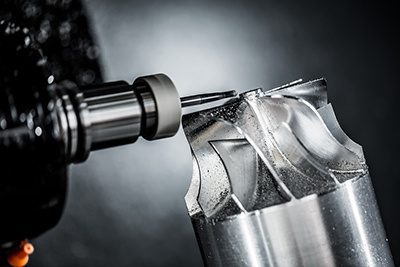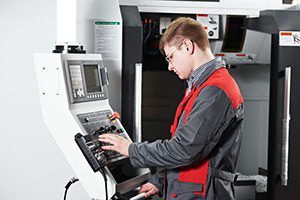Horizontal vs. Vertical Milling: Which Is Best For Your Metalwork Job?
Milling is one of the most commonly used processes in the metal fabrication industry today, offering skilled tradesmen a method for expertly cutting and shaping rolled steel. Although there are many different types of milling centers being used across the industry, they are generally categorized as vertical machining centers and horizontal machining centers. Vertical Mills features spindles (cutting elements) that are aligned vertically. Horizontal Mills have a spindle that is parallel to the ground. Although the job of both machine types is the same, the production method of job completion looks a little differently. There are pros and cons to both machining choices, and it’s important to note that milling capabilities can vary between the two categories. But, when the right machining center is combined with the best operators, your specific metalwork job will be completed with precision craftsmanship.
Vertical Machining Centers
The Pros
Popularity: Vertical Machining Centers make up the majority of milling machinery across the industry. They typically cost less than horizontal machining centers, making them a wise investment that pays for itself over and over again for metal fabrication shops. Their lower upfront costs usually mean that production cost savings are passed onto customers. Because these types of mills are so common, there are a higher number of skilled operators throughout the industry equipped to use the machines.

Ease of Operation: Due to the structural design on VMC’s, operators have greater visibility while working on these machines. This allows operators to more easily catch and correct potential problems during the milling process. The user-friendly CNC controls make programming simple. This means that operators can spend less time on setup and programming and more time ensuring that the specs of your project are completed while meeting the highest of expectations.
Production Benefits: The visibility offered by VMC’s is ideal for completing large plate metal fabrication. Because of their ease of use, VMC’s are the perfect choice for less complex jobs that require lower quantities. For quick milling jobs, these machines are the perfect solution.
The Cons
Production Output: When compared to Horizontal Mills, VMC’s can’t typically compete in terms of production output. They are not the best choice in terms of time and cost efficiency for large quantity, more complex machining jobs.
Risk of Human Error: Because this type of mill allows operators a chance to “eyeball” the work as it’s being completed, there is a greater risk of introducing human error into an otherwise computer-programmed equation. It’s important to ensure that the highest quality operators are employed to oversee each milling job from start to finish to reduce the number of errors that might occur throughout the process.
Horizontal Machining Centers
The Pros
Chip Evacuation: Because of the setup of horizontal mills, gravity aids the process of pulling the chips out during the cutting process. This means that the end products typically have cleaner surface finishes and require less production or fabrication later on throughout the process.
 Solid Construction: Horizontal mills are built more heavily and are capable of handle larger volume production jobs. The construction of each of the machine parts is designed to last longer under the specific forces at work for HMC’s. This rigid construction means that machines vibrate less, deflect less, and function more smoothly when compared to vertical mills.
Solid Construction: Horizontal mills are built more heavily and are capable of handle larger volume production jobs. The construction of each of the machine parts is designed to last longer under the specific forces at work for HMC’s. This rigid construction means that machines vibrate less, deflect less, and function more smoothly when compared to vertical mills.
Productivity: Because of the 4th Axis Tombstone and an integrated pallet changer, these machines improve productivity, a feature that is ideal for complex, large quantity workloads. Because of the mechanical design, one HMC can do the work of up to three separate machining tools. This is optimal for time and production cost efficiency.
The Cons*
*Industry experts agree that the downsides associated with HMC’s are actually good problems to have, and are not all that bad.
Expensive: Horizontal Machining Centers cost significantly more than vertical mills do. Typically, fabricators that own these machines have been established for some time and have worked their way up to owning these machines. See, that’s a good problem!
Chance of Error: As with most things, the chance of error exists. As opposed to VMC’s that introduce the chance of human error due to “eyeball opportunities”, Horizontal Machining Centers run the risk of errors occurring because visibility can be limited due to the tombstone-spindle placement. Operators have less visibility to catch mistakes that might occur and correct them before they become disastrous.
 Fewer Trained Operators: Because HMC’s are less common across the nation (due mostly to upfront purchase and maintenance costs), there are fewer skilled operators available to run these machines. Fortunately, even this con has an advantage. Because the pool of “experts” is smaller, those who do have the skill to operate HMC’s are typically more experienced and knowledgeable, helping to ensure that each project is completed with precision.
Fewer Trained Operators: Because HMC’s are less common across the nation (due mostly to upfront purchase and maintenance costs), there are fewer skilled operators available to run these machines. Fortunately, even this con has an advantage. Because the pool of “experts” is smaller, those who do have the skill to operate HMC’s are typically more experienced and knowledgeable, helping to ensure that each project is completed with precision.
Whether you’re in need of maintenance machining or production machining, Swanton Welding has the full capabilities necessary to complete the work with precision, accuracy, and efficiency. Our highly skilled craftsmen and the knowledge and experience necessary to ensure that your job is completed with excellence that you can depend on. We are equipped with the highest quality equipment in the industry and can handle the workload, no matter how large or small, with ease. Call 419-826-4816 today to learn more.

